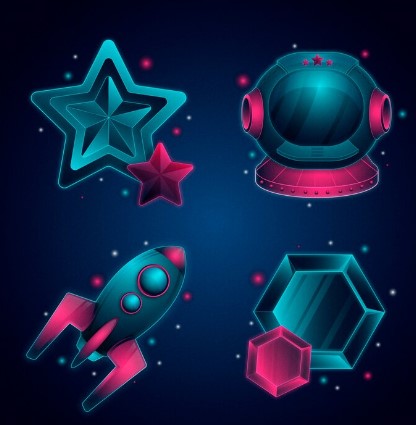The “Halo” video game franchise has transcended the industry, evolving into a cultural phenomenon that has captivated millions. From the thunderous debut of Master Chief and the Covenant in 2001 to the present day, the narrative of Halo weaves a tale of futuristic warfare, AI consciences, and the eternal mystery of the Halo rings themselves. Yet, nestled within the grand storyline, there’s a quieter saga of growth and change that’s equally as compelling: the design evolution of Halo banners and game icons. Our odyssey through the visual identity of a gaming giant is about to begin.
The Genesis – Halo: Combat Evolved (2001)
It all starts with the original – “Halo: Combat Evolved,” a title that would redefine first-person shooters and breathe life into the nascent Xbox console. The banner for this pivotal game is a piece of art embedded in the history of gaming. It speaks volumes with its minimalist approach. Against a nebular backdrop, the emblem of the UNSC (United Nations Space Command) proudly sits. It’s bold, clean, and sets the precedent for the iconic Halo aesthetic of blue and steel.
The game icon is equally straightforward, synonymous with all the franchise’s core elements: the golden ring, the definitive symbol of Halo games, ensconced within the game’s angular typography. The powerful simplicity of these beginnings is a testament to the clarity of vision and the power of understated design.
The Metamorphosis – Halo 2 (2004) and Halo 3 (2007)
Three years later, “Halo 2” emerges with its own banner, a more literal representation of the game’s narrative. The Master Chief, the series’ indomitable protagonist, steps forward with Earth in the background, hinting at the game’s groundbreaking feature of urban combat on our home planet. The game icon, however, remains true to the original with the notable addition of a slash, symbolizing conflict and continuity.
With “Halo 3,” the franchise reaches new heights, and so does the intricacy of its banner. We witness the Chief, shield raised, backdropped by the ominous Halo array, promising a grand finale. The game icon refines the art further – the slash now more segmented, signifying the trilogy’s conclusion. It’s a balance of new and old, of simple lines and more detailed scenes.
The Ascendance – Halo 4 (2012) and Halo 5: Guardians (2015)
Enter the Reclaimer Saga, marking Master Chief’s emotional and visual evolution. “Halo 4” introduces a banner with a gorgeous golden hue, a comforting callback to the series title, yet tinged with Forerunner intricacies, as the Didact looms in the background. The icon, a rift between two halves, embodies a deeper dissonance in the traditional formula – an apt reflection of the game’s thematic and narrative modernization.
“Halo 5: Guardians” takes a step into the complex, mirroring the narrative layering of the game with a multi-faceted, multi-colored banner that comes alive in motion. The game icon follows suit, with the rift now twisted into a convoluted whole, with the ancient Forerunner symbol of the Mantle, a fitting harbinger of the game’s introspective themes. These designs are more than mere banners – they are windows into the larger universe Halo is becoming.
The Future-Facing – Halo Infinite (2021)
With much anticipation, “Halo Infinite” is on the horizon, promising a return to the series’ roots while looking ahead. The banner released with the game’s debut is a snapshot of its own development – the Master Chief, looking more rugged, framed by the infinite backdrop of a Halo, paying homage to its namesake and echoing the sentiment of returning to one’s origins. The game icon is yet to be unveiled, but it carries the heavy mantle of representation for a game that is more than a mere sequel.
Deconstructing the Halo Mystique – What Makes a Good Banner?
The evolution of banners and icons in the Halo series is more than meet-the-eye visuals. It’s a cohesive blend of narrative foresight, audience connection, and brand development. But what specific design elements elevate these digital flags from mere artwork to intangible extension of a beloved universe?
Clear Composition and Readability
The first step in an effective banner is a clear composition. In the case of Halo, it’s essential that even from a distance, you can make out the UNSC emblem, the Master Chief, an opposing force, or any other central element. Readability should be a priority, ensuring the artwork isn’t cluttered and that elements don’t mesh together to create visual confusion.
Narrative Resonance
A good banner doesn’t just exist within the game; it teases the story, embodies a key moment, or promises an experience. The Halo banners have consistently managed to encapsulate key narrative points – from setting to adversary, they are a visual synopsis of what players can expect. This resonance is what transforms an image into a story that invites players in.
Timeless Appeal with Room for Growth
Each new game in the series brings with it the challenge of evolving the visual branding without losing the series’ identity. The Halo banners have always managed to strike a balance between an iconic look that fans can instantly recognize and a design that hints at the growth and changes within the universe. The ability to evolve while staying true to the core is the mark of great design, finding the fine line between tradition and innovation.
Interactivity and Motion
In the digital age, static banners have given way to moving images that captivate and tell more comprehensive stories. Halo 5’s banner went a step further, with an interactive 3D model that fans could explore. This kind of interactivity not only makes the banner more engaging but also opens up countless design possibilities.
The Legacy of a Banner – Beyond the Art
For Halo fans, the banners are much more than promotional pieces of art. They are love letters to the lore, anticipatory tools that stir excitement, and visual bookmarks that tie together their myriad experiences in the Halo universe. The banners live on in fan art, cosplay, and the collective imagination of gamers.
In an era where games are announced years in advance, the importance of these banners is underscored – they must sustain the hype, often in the absence of concrete gameplay footage or story details. This balancing act between substance and anticipation is one that the Halo series carries off with aplomb.
In Conclusion – A Banner of Admiration
The banners and icons of the Halo series form a tapestry of design, a reflection of the game’s enduring iconography and narrative depth. In our deconstruction, we find that the true power of these images lies not in their aesthetics alone, but their ability to connect with fans on a profound level. They are the silent yet potent heralds of the adventures that await, and in that light, they are as much a part of the Halo legacy as the game itself.
Halo banners are not just marketing materials; they are the frontiers of the artistic expression of this multi-dimensional universe. With the advent of each game, they reinvent themselves while carrying the weight of their predecessors. In this delicate dance, they showcase the growth and change of the series, while always remaining unmistakably Halo.
Halo is not just a game; it’s an icon. And the banners and icons that represent it are pixelated testaments to the colossal universe we’ve all come to know and love. They are as crucial to the experience as the legendary soundtrack, the immersive gameplay, and the compelling storylines. These visual ambassadors stand at the entrance of a world that’s infinite in its own right, perpetually beckoning us to step inside and become a part of the myth.
The story of the Halo banners and game icons is still unfolding, promising to captivate and inspire us as they have always done. They are constant reminders of the intertwining threads of design and narrative; the art of digital storytelling at its best. As we look towards a future with Halo Infinite and beyond, one can only imagine the breathtaking banners that await us – ready to become the next chapters in the design odyssey of one of the greatest game franchises of all time.



